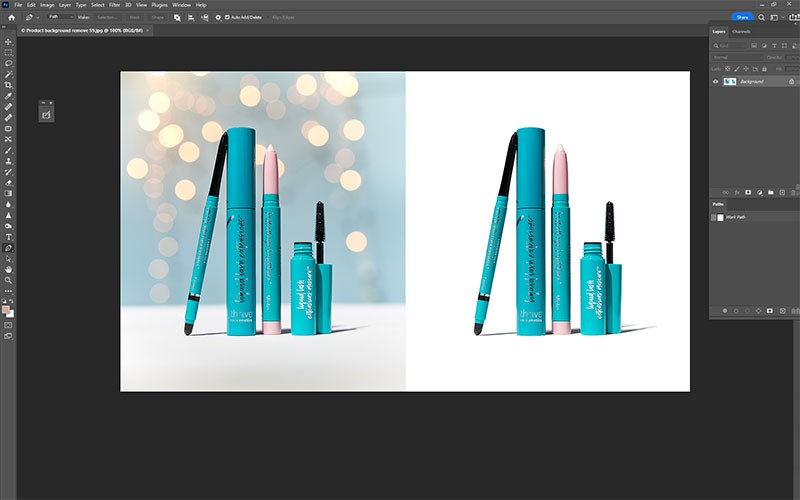Picture Perfect: Unleash the Power of Background Removal
In the ever-evolving landscape of digital content creation, the process of removing backgrounds from images has become a pivotal aspect. Whether you're a graphic designer, photographer, or content creator, the ability to isolate subjects from their backgrounds opens up a realm of creative possibilities. This article delves into the intricacies of background removal, exploring various methods, tools, and considerations to achieve professional and visually appealing results.
Definition of Background Removal
The fundamental concept of background removal involves isolating the main subject in an image from its surroundings. This process enables creators to manipulate, replace, or enhance the background, contributing to a more visually striking composition.
Importance in Visual Content
In the visually-driven world of digital media, the importance of background removal cannot be overstated. It allows for the creation of captivating visuals, making images more versatile and adaptable for various purposes.
Evolution of Background Removal Techniques
From manual editing to cutting-edge artificial intelligence, the techniques for background removal have undergone a significant evolution. Understanding this progression is key to utilizing the most effective methods available.
Why Remove Backgrounds?
Enhancing Visual Appeal
The removal of distracting or irrelevant backgrounds enhances the overall visual appeal of an image. It directs the viewer's focus to the main subject, creating a more compelling and aesthetically pleasing composition.
Highlighting the Subject
Background removal is a powerful tool for emphasizing the subject of an image. By isolating the main element, creators can draw attention to specific details, conveying a clearer message or story.
Creating Versatile Content
Images with transparent backgrounds offer versatility in their use. They can seamlessly integrate into various design projects, presentations, or marketing materials without clashing with different color schemes.
Manual Selection and Deletion
In the early days of image editing, removing backgrounds was a labor-intensive process involving manual selection and deletion of unwanted elements. This method, though time-consuming, laid the foundation for contemporary techniques.
Chroma Keying in Videography
Videographers pioneered the use of chroma keying, a technique where a specific color (usually green or blue) is replaced with a different background during post-production. While effective, this method is more applicable to video than static images.
Challenges and Limitations
Traditional methods posed challenges, especially when dealing with intricate details like hair or complex backgrounds. The limitations of these approaches paved the way for the development of digital tools.
Digital Tools for Background Removal

Photoshop and Advanced Editing
Adobe Photoshop revolutionized the field with advanced editing capabilities, including tools for background removal. While effective, it requires a certain level of expertise and can be time-consuming for large batches of images.
AI-Powered Background Removers
The rise of artificial intelligence ushered in a new era of background removal. AI-powered tools leverage machine learning algorithms to automatically detect and isolate subjects, streamlining the editing process.
Comparisons and Considerations
Choosing between traditional methods, advanced editing software, and AI-powered tools depends on factors such as the complexity of the task, the desired level of precision, and the available time.
Step-by-Step Guide for Manual Background Removal
Selecting the Right Tool
Before diving into the editing process, it's crucial to choose the right tool for the job. Whether using manual techniques or digital software, selecting the appropriate tool sets the foundation for a successful edit.
Tracing and Isolating the Subject
In manual removal, precision is key. Carefully tracing the outline of the subject ensures a clean cut. Digital tools may employ selection algorithms, but user intervention is often required for fine-tuning.
Fine-Tuning and Refinement
After the initial isolation, fine-tuning the edges and making necessary adjustments is essential for achieving a seamless result. This step is where attention to detail pays off in the final quality of the image.
Understanding Image Masking

Introduction to Masking
Image masking is a technique closely related to background removal. It involves creating a mask that designates which parts of an image are visible and which are hidden, allowing for selective editing.
Types of Masks
Different types of masks, such as layer masks and clipping masks, offer varying levels of control over the editing process. Understanding these distinctions empowers editors to choose the most suitable method for a given task.
Applications in Background Removal
Incorporating image masking techniques into background removal adds a layer of precision and control. It is particularly useful in scenarios where traditional selection methods may fall short.
AI-Powered Background Removal Tools

Overview of AI Technology
Artificial intelligence, with its ability to analyze patterns and learn from data, has revolutionized background removal. Understanding the underlying technology provides insights into the efficiency of AI-powered tools.
Benefits of AI in Background Removal
AI excels at automating repetitive tasks, making it an invaluable asset in background removal. Speed, accuracy, and the ability to handle large volumes of images are key benefits of AI-powered solutions.
Popular AI Tools in the Market
An overview of popular AI-powered background removal tools, including their features and user experiences, assists creators in making informed choices based on their specific needs.
Achieving Professional Results
Maintaining Image Quality
Regardless of the method used, maintaining the overall quality of the image is paramount. Avoiding pixelation, artifacts, and loss of detail ensures a professional-looking final result.
Handling Complex Backgrounds
Professional results often involve working with complex backgrounds. Techniques such as feathering, blending, and adjusting transparency contribute to a seamless integration of the subject into new surroundings.
Tips for Seamless Edits
Tips and tricks for achieving seamless edits, such as paying attention to lighting, shadows, and color matching, play a crucial role in elevating the quality of background removal.
Challenges and Solutions
Dealing with Hair and Fine Details
One of the perennial challenges in background removal is handling fine details like hair. Specialized tools and techniques, including the use of brushes and refining edges, address this common issue.
Addressing Color Variations
Background removal may expose color variations between the subject and the new background. Color correction tools and techniques help harmonize the overall color palette for a cohesive final result.
Resolving Issues with Reflections
Reflections and shadows in the original background can pose challenges. Creative approaches, such as adding artificial shadows or adjusting lighting, contribute to resolving these issues.
The Role of Background Removal in Different Industries
E-commerce and Product Photography
In the e-commerce realm, where product images are crucial for online sales, background removal enhances the focus on the product, providing a clean and professional appearance.
Graphic Design and Advertising
Graphic designers and advertisers leverage background removal to create visually striking advertisements and marketing materials. The versatility of edited images allows for seamless integration into various campaigns.
Film and Entertainment Industry
Background removal in the film and entertainment industry is a common practice, enabling filmmakers to place actors in diverse and fantastical settings. The seamless integration of CGI elements often relies on advanced background removal techniques.
Legal and Ethical Considerations
Copyright and Usage Rights
Understanding and respecting copyright laws and usage rights is essential when editing and using images. Creators must be aware of the legal implications of background removal, especially when the original image is not their own.
Respecting Privacy in Image Editing
Privacy considerations come into play when editing images that include individuals or private spaces. Consent and ethical practices should guide the decision to edit or publish such images.
Best Practices for Ethical Background Removal
Establishing best practices for ethical background removal involves transparency, consent, and adherence to legal guidelines. Creators should prioritize integrity in their editing processes.
Future Trends in Background Removal
Advancements in AI Technology
The future of background removal lies in continual advancements in AI technology. Predictive algorithms, enhanced learning capabilities, and increased automation are on the horizon.
Integration with Augmented Reality
As augmented reality continues to gain traction, the integration of background removal in AR applications opens up exciting possibilities for immersive and interactive visual experiences.
Predictions for the Next Decade
Anticipating the trajectory of background removal in the next decade involves considering technological innovations, user demands, and the evolving landscape of visual content creation.
Case Studies
Successful Campaigns with Background Removal
Examining case studies of successful campaigns that employed background removal provides insights into the impact of this editing technique on audience engagement and brand perception.
Before and After Transformations
Visualizing before and after transformations showcases the transformative power of background removal. Case studies featuring notable improvements in image quality and composition offer practical inspiration.
Impact on Engagement and Conversions
Analyzing the impact of background removal on user engagement and conversions in various industries sheds light on the tangible benefits of investing time and resources in this editing process.
User Tips and Tricks
Maximizing Efficiency with Shortcuts
Experienced editors often employ time-saving shortcuts and techniques to streamline the background removal process. Sharing these insights benefits both beginners and seasoned professionals.
Avoiding Common Mistakes
Identifying and avoiding common mistakes in background removal, such as over-editing or neglecting fine details, contributes to the overall improvement of editing skills.
Exploring Creative Possibilities
Encouraging users to explore creative possibilities beyond basic background removal sparks innovation and originality in visual content creation.
Tips for Effective Background Removal Workflow
Organizing Your Workspace
Efficient background removal starts with an organized workspace. Arrange your tools and reference materials for a smoother editing process.
Utilizing Keyboard Shortcuts
Mastering keyboard shortcuts enhances your speed and efficiency. Familiarize yourself with shortcuts specific to your chosen editing software.
Creating Backup Copies
Before starting a major background removal project, create backup copies of your original images. This precaution ensures you can revert to the original if needed.
Exploring Advanced Techniques
Gradient Mapping
Utilize gradient maps for seamless blending of subjects into new backgrounds. This technique adds depth and realism to your edited images.
Smart Object Integration
Leveraging smart objects in Photoshop allows for non-destructive editing. This means you can make changes without altering the original image data.
Incorporating Textures
Experiment with adding textures to your background-free images. This enhances visual interest and can be particularly effective in artistic or thematic projects.
Navigating Common Editing Software
Adobe Photoshop
Explore the various tools and features dedicated to background removal in Photoshop. Familiarity with these functions empowers editors to achieve precise results.
GIMP (GNU Image Manipulation Program)
GIMP, a free and open-source alternative to Photoshop, offers powerful background removal capabilities. Learn the specific tools and techniques unique to GIMP.
Online Platforms and Apps
Discover user-friendly online platforms and apps that cater to those seeking a quick and easy background removal solution. These are ideal for beginners or those with minimal editing needs.
Industry Expert Insights
Interviews with Graphic Designers
Gain insights from graphic designers who routinely incorporate background removal into their work. Learn about their favorite techniques and any challenges they've overcome.
Photography Studio Perspectives
Explore how photography studios integrate background removal into their workflow. Understand the impact on client satisfaction and the visual appeal of their portfolios.
AI Developers' Vision
Delve into the perspectives of AI developers working on background removal algorithms. Understand the challenges they face and their vision for the future of AI-driven image editing.
Your Journey to Background Removal Mastery

Continuous Learning
Emphasize the importance of continuous learning in the field of background removal. New techniques and tools emerge, and staying informed keeps you at the forefront of image editing.
Joining Creative Communities
Connect with fellow editors and creators in online communities. Share your experiences, learn from others, and stay inspired by the diverse approaches to background removal.
Showcasing Your Portfolio
Building a portfolio showcasing your background removal projects serves as a testament to your skills. Highlight before-and-after comparisons and diverse applications to attract potential clients or collaborators.
Recap of Key Points
A comprehensive recap of key points emphasizes the importance of background removal, the evolution of techniques, and the diverse applications across industries.
Encouraging Experimentation and Learning
The conclusion encourages readers to experiment with different methods, tools, and creative approaches in their background removal endeavors.
Embracing the Evolution of Image Editing
The final message highlights the continuous evolution of image editing, with background removal playing a central role in shaping the future of visual storytelling.
